Menu

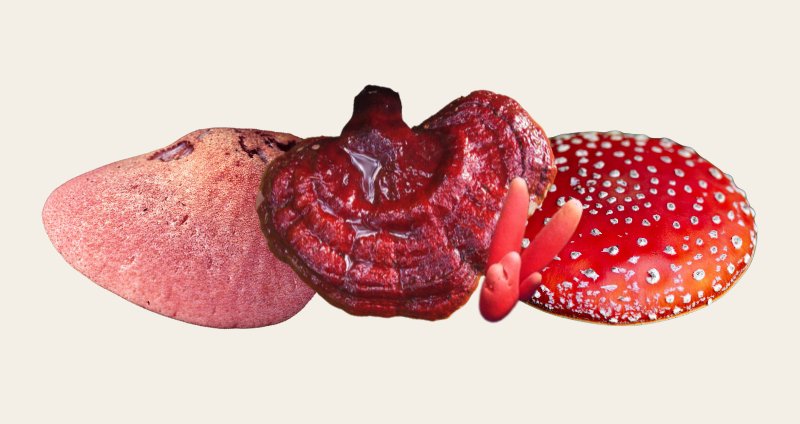
Red mushrooms are highly fascinating due to their bright colors and unique shapes. These species sometimes sprout in lawns from seemingly nowhere and create beautiful clusters of red and orange hues.
“Nature alone is antique, and the oldest art is a mushroom.”
— Thomas Carlyle
Despite their striking appearance, only some varieties of red mushrooms are edible species, while others are among the most poisonous mushrooms you should definitely avoid. So, how can you differentiate between the two types of red mushrooms?
To ensure you make the right distinction, we’ll help you understand the following:
The line between poisonous and edible mushrooms is often thin because they all look similar to the untrained eye. This is why you must get your facts straight before consuming any red mushroom!
Caution: We highly advise you to accompany an experienced mushroom hunter to learn how to identify wild mushrooms for consumption. A spore print is sometimes the only way to be certain of a mushroom type, even for experienced mushroom aficionados
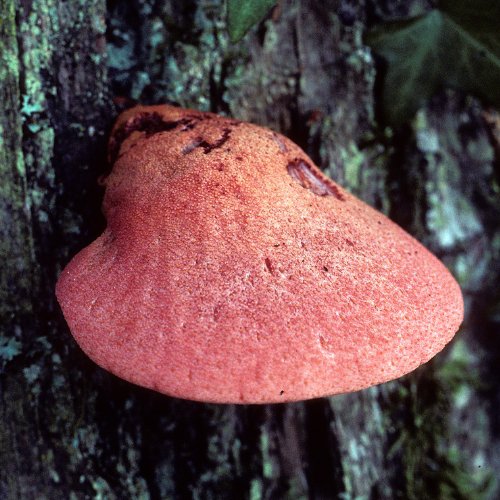
Fistulina hepatica is an edible mushroom that’s an excellent meat substitute. It’s also referred to as “ox tongue” because its size and shape sometimes resemble a big tongue.
In other areas, it’s named “beefsteak” as its texture is similar to that of meat, and it has a red fluid that resembles blood. Some people have also likened its appearance to that of the liver.
This variety of red edible mushrooms is common in Europe, especially in forested areas. It also grows in North America, Africa, and Australia, usually in season from late summer to fall.
Fistulina hepatica is relatively rare. It’s not cultivated commercially and is mostly found through foraging. It’s also unique compared to other red mushroom species due to its crimson color and peculiar shape.
This type of red mushroom is parasitic and saprophytic and prefers growing on tree species such as chestnut and oak. It typically develops in small groups on decaying stumps or tree trunks that are still covered in foliage.
Fistulina hepatica have a sour and acidic taste which becomes stronger as the mushroom grows. This is why they’re often prepared in cream-based recipes. They’re also one of the few mushroom species that can be consumed raw.
As Fistulina hepatica grow, they change color from red to brown and become softer and more gelatinous. They contain vitamin C, an antioxidant that helps support the immune system, and are rich in fiber, folate, and potassium.
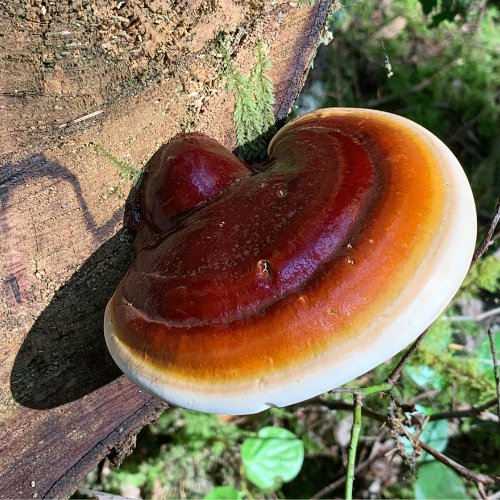
Reishi mushrooms, sometimes referred to as Ganoderma lucidum and lingzhi, are fungi indigenous to Europe, Asia, and North America. They favor tropical, subtropical, and temperate regions with many deciduous hardwoods like oak and maple.
Reishi mushrooms are typically in season from late summer through autumn when they reach full maturity. According to one study, reishi only grows on two to three of every mature hardwood tree, with oak and maple being the most prevalent [1]. The mushroom is hard, and its underside has tiny pores instead of gills.
Since this type of red mushroom mainly thrives in the wild and is in high demand, farmers have now started growing them.
There are other colors of reishi, but the red reishi (Ganoderma lucidum) has been the most referred to in classical Chinese Medicine texts and the most studied in scientific literature for its multiple health benefits.
The growing demand for reishi mushrooms comes from their abundant health benefits, including the following:
Most people prefer consuming reishi mushrooms in the form of capsules or extract powders. Unfortunately, due to the popularity of this species, there’s been an influx of fake or mislabelled supplements on the market, so be on the lookout when purchasing reishi supplements.
Expert Tip: The amount of reishi mushroom you take will depend on the product you're using (e.g., powders, capsules, or blends). Always follow the directions provided by the manufacturer, especially if you’re consuming reishi extract.
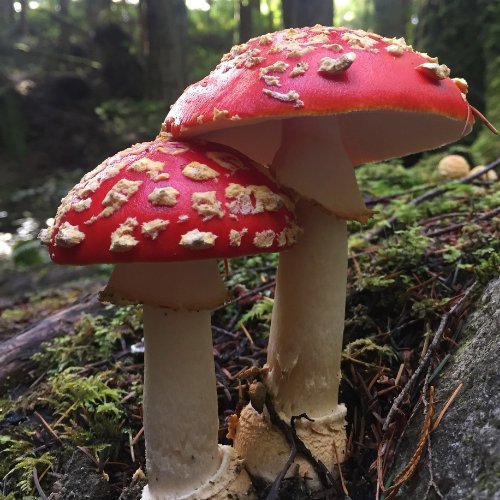
The Amanita muscaria is one of the most common types of red-capped wild mushrooms. It’s sometimes referred to as the fly agaric. It’s extremely easy to identify because of its prominent red cap with white flecks.
The Amanita muscaria has a large, glossy, vividly red cap held up by a long white cylinder-shaped stalk. This particular species of red mushroom is the inspiration behind the signature mushroom in popular media, from the Super Mario video game to classic fairy stories.
At first, this mushroom’s crown resembles a white egg when it pops up from the ground. It then gradually assumes a hemispherical shape and turns yellow or orange before finally turning red.
This species of red mushroom becomes wider as it grows, eventually reaching a diameter of up to eight inches. Its surface becomes covered in irregular white spots that resemble warts. These spots are simply the remnants of the white, spikey, egg-like “shell” the mushroom emerges from.
Watch the video below to see a timelapse of Amanita muscaria growing and emerging from its “shell.”
The Amanita muscaria is being studied for its potential health benefits. It appears to support a healthy inflammation response [5], for example. It has also piqued the interest of humans throughout history for its psychedelic properties [6,7].
Interestingly, these types of red-capped mushrooms are considered to be both edible and toxic because the euphoric substances they contain also double as toxins. Amanita muscaria ingestion can be poisonous to humans when consumed in large quantities.
The mushroom poisoning symptoms appear very soon after consumption. Symptoms can include dizziness, disorientation, convulsions, fainting, abdominal discomfort, vomiting, dysentery, and profuse sweating.
These effects vary greatly from one person to another based on the amount of the Amanita muscaria taken and the potency in different samples.
Botanical Note: The bright red cap of Amanita muscaria is due to the presence of pigments that may also act as a deterrent to predators.
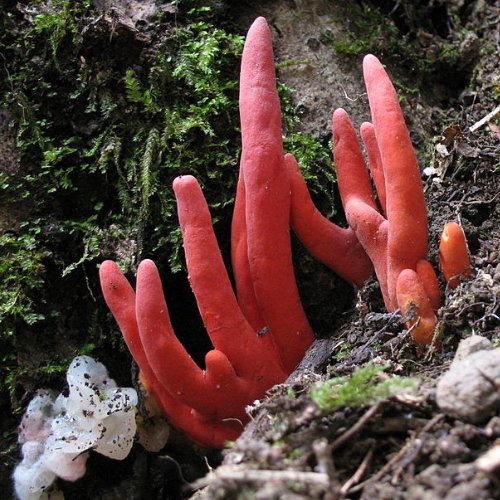
The poison fire coral, known scientifically as Podostroma cornu-damae, is one of the deadliest poisonous red mushrooms in the world. In fact, it’s the only toxic mushroom known to researchers whose toxins can be absorbed by the skin and cause inflammation and dermatitis.
If this red mushroom is ingested, it can cause cardiac arrest and, in severe cases, even death.
Its common name is accurate to its appearance. It is red, sometimes with orange hues, and has coral-like branches that emerge from the earth. The overall effect looks like the flames of a fire.
It's one of the most poisonous fungi and has been identified as a quarantine pathogen [8]. This means that it’s dangerous to plant health and should not be used or imported into the EU Member States.
This species thrives in Asia and Australia and can be found near mulch and decomposing plants as well as in soil and wood chips.
The poison fire coral grows independently, and its spores are carried by the wind to new locations. It thrives in damp environments and, if it spreads to residential areas, can release its poisonous spores.
Interesting Insight: Unlike most mushrooms, the poison fire coral’s bright red color serves as a warning signal in nature, indicating its toxic nature to potential predators.
Some varieties of red-colored mushrooms look similar. So, if you're going mushroom hunting for the first time, it’s important that you know which species you can consume and which ones you should steer clear of.
Never taste a mushroom to determine whether it’s harmful or safe. Some inedible species, such as the Amanita phalloides, have a delectable flavor. Always refer to their physical features to make a distinction, and use a spore print to be certain of your identification.
However, if you’re looking to take advantage of the health boosting properties of the storied red mushroom, reishi, we recommend that you get your extract products from a reliable and reputable seller. That way, you’ll ensure your product isn’t adulterated with fillers, grains, or mycelium.
So there you have it. There are multiple species of red-colored mushrooms, and while some can deliver a toxic punch, others, like reishi, can provide unique health-supporting properties when taken as a supplement.
Our goal at Real Mushrooms is to provide you with the best mushroom (fruiting body) extracts in their purest form, free of carriers or grain fillers.
With more than 40 years of mushroom cultivation experience, we work hard to ensure that our products are evaluated for key health-supporting components and are in line with industry standards.
This is why, when you sample our mushroom products, you have the highest chance of experiencing the distinctive benefits that each mushroom has to offer.If you're looking for high-quality mushroom extracts, take a look at our range of products. You’ll definitely find something that you like.


Disclaimer: The information or products mentioned in this article are provided as information resources only, and are not to be used or relied on to diagnose, treat, cure, or prevent any disease. This information does not create any patient-doctor relationship, and should not be used as a substitute for professional diagnosis and treatment. The information is intended for health care professionals only. The statements made in this article have not been evaluated by the Food and Drug Administration. Any products mentioned are not intended to diagnose, treat, cure, or prevent any disease. The information in this article is intended for educational purposes. The information is not intended to replace medical advice offered by licensed medical physicians. Please consult your doctor or health practitioner for any medical advice.